Article
The Faces, Spaces and Places of St. Louis
Author(s):
There's more than history to this city of 34 museums. For one thing, it has the greatest number of free attractions than any city in the United States other than Washington, D.C.
Photography by the authors
St. Louis, Mo., has seen the excitement of Lewis and Clark, the schism of the Civil War, the triumph of Charles Lindbergh and now, one could say, its rejection by Albert Pujols who needed to be offered more than the Cardinal’s’ $200 million for the next 10 years.
But visitors find there’s more than history to this city of 34 museums that spreads over the west bank of the Mississippi River. For one thing, it has the greatest number of free attractions than any city in the United States other than Washington, D.C.
“And furthermore,” says Jason Arnold, a spokesperson for the Vin de Set restaurant in Lafayette Square, “in St. Louis, your dollar goes farther!”
vingt dix-sept
His menu prices back him up. Choices for the fixed price dinner (three items for $30) include an Eggplant Napoleon that is out of this world. This Provencal-style restaurant characterizes two points about this proud but friendly city: First, it doesn’t take itself too seriously. The name “vin de set” is its tongue in cheek phonetic rendering of its address at 2017 on Chouteau Avenue for the French, . And, second, this city does not waste buildings; it holds on to its past. The building was once the Joseph Schnaider Brewery malt house but new owners saw its possibilities. A statue of King Louis IX on horseback from the 1904 World Fair was found amongst junk in the basement and now prances haughtily above the bar.
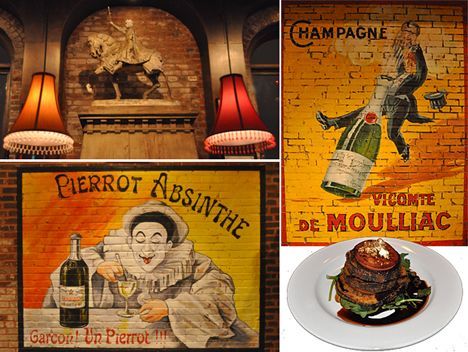
places
“This is one of the best places to eat in town,” he says. “St. Louis is full of special like this —
faces
spaces
The bartender is clearly used to talking to tourists. and we have the special of our Cardinals baseball team, and special like our Forest Park. Did you know it is bigger than Central Park in New York?”
Spaces
The obvious space is that around the Gateway Arch, which, with the Museum of Westward Expansion below it, constitutes the Jefferson National Expansion Memorial. That’s quite a mouthful but so was the chutzpah to build a stainless steel arch 630 feet tall. It cost $13 million and was completed in 1965.

Forest Park is indeed bigger than Central Park —
by 500 acres. Today it’s the home of the Missouri History Museum, the Missouri Historical Society Library, the St. Louis Zoo and the St. Louis Art Museum, where a more formal Louis IX looks down from his horse.
Another statue, this one of Linnaeus, stands in the Missouri Botanical Garden, the Victorian home of horticulturist Henry Shaw. Opened two years before the Civil War, it is the oldest public garden in the United States.
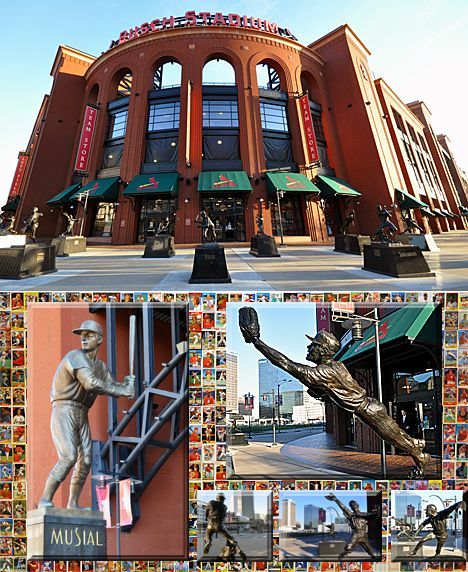
Busch Stadium is another special place in town even though Pujols is no longer a card-carrying Cardinal. The magnificent statues grouped at the entrance once surrounded the periphery of the former stadium where each, separate, seemed to have more impact to us. Mary Hendron, a city booster, hotly defends the grouping.
The statues include Ozzie Smith making one of his stupendous shortstop catches, Red Schoendienst turning a double play from second base, George Sisler (the old-time Browns’ greatest player —
There’s Lewis and Clark, who, literally, put St. Louis on the map (Clark is buried here); Dred Scott who sued as a slave for his freedom (creating one of the issues that led up to the Civil War); Charles Lindbergh who with his airplane left his unique mark on the city (photographed with his mother here at the Missouri History Museum, the Orteig prize he won for his courageous flight to France in the next display case); and Judy Garland and Chuck Berry. Famous names have become the famous faces of St. Louis.
Faces
Places
anywhere
“This is a 20-minute town,” says Nancy Milton, who with her partner, Mary Hendron, runs Insight St. Louis. She explains with the interstates 44, 55, 64 and 70 crisscrossing the city you can get in this city in that time frame.

Yes, but could she or anyone explain the City Museum? We doubt it. This fun museum defies description; a mélange of leftovers that would either make a bunch of curators shudder at the contents or, if they were frugal, make them whoop with excitement. What it has is a mixture of Salvatore Dali-like teases of sharks eating sailboats and whimsical tributes to glass and flippant museum pieces like the world’s largest underpants and a bus overhanging the roof and...
You have to see it to understand, but do go. Children will love its whimsy.
“They are our Hall of Famers. They deserve to be together!” she exclaims. he batted over 400 twice), and the great Bob Gibson at the end of his famous follow-through. And, of course, the legendary Stan “The Man” Musial. St. Louis put up his statue in 1998 on the 50th anniversary of his greatest season, 1948, when he led the league in average, runs, hits, total bases, doubles, triples, RBI and slugging percentage. He hit 475 career home runs.
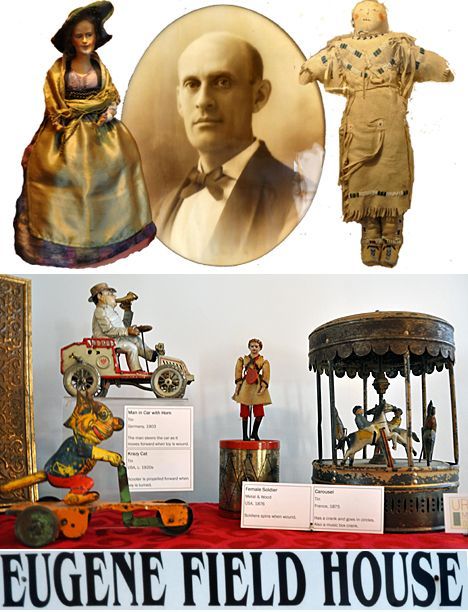
He was a poet, “Wynken, Blynken and Nod,” and writer of children’s books —
Children will also love the Eugene Field House Toy Museum. Eugene was the son of Roswell Field, Dred Scott’s lawyer in his slave freedom lawsuit. Both lived in this house but Eugene has left more of his life here. and a collector of children’s toys. He had more than 2,000 toys before his death, but all except nine were lost in a fire (seven are on show in the museum). Many toy collections are exhibited here.
A larger collection as difficult to classify as that of the City Museum stands in the gentrified Delmar Loop inside the restaurant and music club Blueberry Hill. The Loop was the turn around area for the long-gone city trams but rumor has they might make a comeback here.
“It was hard to catch a person’s life in 10 lines,” Joe says.
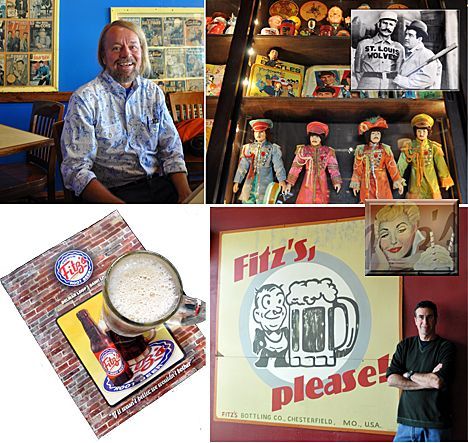
The stars name persons whose lives have touched St. Louis and it’s no surprise that the statue of Chuck Berry stands across the street from this music club because he’s a hometown guy, a friend of Joe’s and a musician who has played in Blueberry Hill’s Duck Room more than 170 times. In that room he plays for 340 persons, two-thirds of whom stand.
It’s somehow typical of low-key St. Louis that a nationally famous musician would play in his hometown for small groups. Locals say it’s because Berry has friends and family in the band, has pride in his persona and enjoys such local feeling. Strangers to this form of music might be interested in what John Lennon said when asked to describe rock ‘n’ roll: “Chuck Berry!” was his reply.
Next to the statue is an old-fashioned, old world Fitz’s, whose home-made root beers might remain the treasured memory from visiting the Loop. This premium root beer started locally in Richmond Heights, a suburb of St. Louis in 1947 as a small very popular drive-in hamburger joint. The owner retired in 1970 foretelling the demise of famous Fitz’s. A new owner re-opened the business at its present location in the Loop in 1993. The building earlier had been a bank then a Chinese restaurant.
“The Delmar Bank had been built solidly because it was scared of John Dillinger who was actively robbing banks at that time,” says owner Michael Alter. “We got an estimate it would take two weeks to demolish the bank and its vault. It took three months! It was worth it because we were the first family-friendly business in the street and today our restaurant is full of locals.” He hands over our root beers and continues: “I suppose you could say we are selling comfort food at affordable prices but we’re selling more. We are selling Americana nostalgia. I believe in today’s web world there are still people searching for places where they don’t need to be plugged in!”
In the Loop we find civic booster Joe Edwards and an assortment from his life as a lover of music that forms the basis for this tourist attraction. Joe has a personal collection of 30,000 vinyl gramophone records! He is a multifaceted character who started the Loop’s Walk of Fame in 1989. The Walk now has 140 stars embedded in the sidewalks of the Loop.
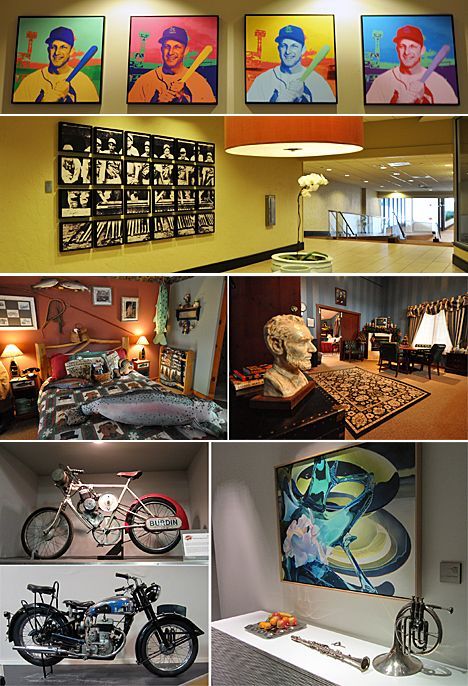
want
But what if you to be plugged in here in St. Louis, home of the World Series Champions, plugged into the world of baseball? For that consider the Hilton St. Louis at the Ballpark, one block from Busch Stadium. It has an excellent roof top restaurant called 360 that gives a magnificent view of the Arch and the Mississippi.
“What was here before the restaurant?” we ask.
“The roof!” our waiter replies.
Like the Millennium hotel nearby it is also close to the Old Courthouse and the Gateway Arch. Those with a car might consider staying at the Lodge at Grant’s Trail especially if they have children. What’s the charm there? A great room with an elk chandelier, a massive fireplace and walls of windows looking out on nature plus nine bedrooms with special themes: The Fishing Life, Alaska, Frontier, Abraham Lincoln and so on. How many times have you wakened up to find yourself gazing at a bust of Honest Abe.
In May 1861, in the street outside the Triumph Grill occurred the “Camp Jackson incident,” the only episode of Civil War fighting to occur in a city whose state had such a bitter divide. A confederate-sympathizing militia planned to take over the Federal Armory but was captured by Union forces. The conflict —
where 27 Confederate and four Union soldiers were killed —
happened outside the very windows of what is now the Triumph Grill.
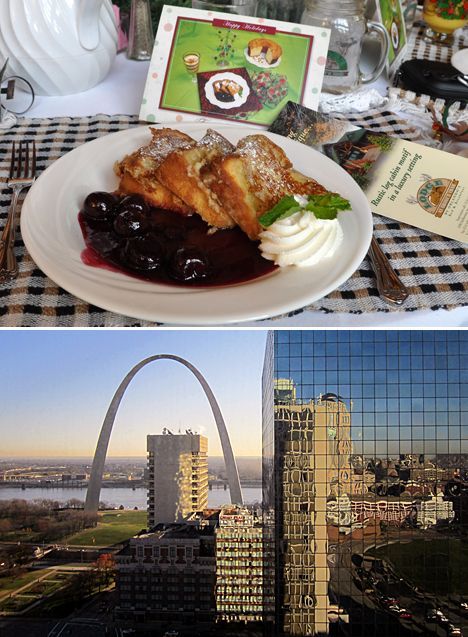
For guests at the previously mentioned Lodge at Grant’s Trail there is a sensational breakfast with the photographed French Toast, which doesn’t use bread but homemade pound cake! Bandana’s Bar-B-Que at 11750 Gravois Road offers tasty lunches with an extensive list of options. Maybe, for your last night’s dining, couples might consider River City Casino, whose promotion elaborately declares “the décor harkens back to the days when Rhett Butleresque gamblers danced with Lady Luck on Mississippi paddlewheelers.
Fancy talk but this enormous casino complex mirrors what has happened in many successful American casinos: the development of stupendously high-quality restaurants. We ate with a small group at the simply named 1904 Steak House. Said one of our group eating with a serene smile on his face: “This is not dining for gamblers. This is dining for Royalty!”
The Man Who Cried Orange: Stories from a Doctor's Life.
The Andersons, who live in San Diego, are the resident travel & cruise columnists for Physician's Money Digest. Nancy is a former nursing educator, Eric a retired MD. The one-time president of the NH Academy of Family Practice, Eric is the only physician in the Society of American Travel Writers. He has also written five books, the last called
Then there’s the 51-room Ignacio boutique hotel owned by St. Louis University that exhibits the university’s art on its walls. The Hotel Ignacio’s elevator has its five floor buttons labeled not with numbers but with notable names: Da Vinci for the first floor, then Puccini, then Botticelli, then Bernini and, for the fifth floor, Michelangelo. The hotel is next door to the Moto Museum with all its array of motor cycles and contiguous with one of the most interesting restaurants in town, the Triumph Grill.




